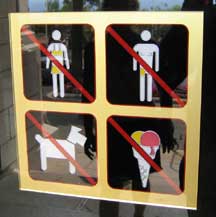European Reflections
by Rev. Dr. Mark D. Roberts June 2004
Note: You may download this resource at no cost, for personal use or for use in a Christian ministry, as long as you are not publishing it for sale. All I ask is that you give credit where credit is due. For all other uses, please contact me at mark@markdroberts.com . Thank you.
| Table of Contents | |
| Part 1 | Does Europe Hate America? Walking Around in Spain |
| Part 2 | Does Europe Hate America? Walking Around in France |
| Part 3 | Does Europe Hate America? Walking Around Italy |
| Part 4 | There Are Lots of Foreigners Here! |
| Part 5 | There's a Lot of Old Stuff Here! |
| Part 6 | Don't Get a Big Head! |
| Part 7 | Who Won? Rome or Christ? |
| Part 8 | The Excellence and Excesses of Art in Worship |
| Part 9 | Images of Jesus in Christian Tradition |
| Part 10 | Recreating the Bible in Our Own Image |
| Part 11 | Michaelangelo's Surpising Sistene Reticence |
| Part 12 | No Shorts Allowed! |
Does Europe Hate America? Walking Around in Spain
Part 1 in the series “European Reflections”
Posted at 10:00 p.m. on Friday, June 4, 2004
I recently returned from a ten-day trip to Europe, during which my wife and I visited Spain, France, and Italy. (Thanks to Ryan Nielsen for posting my blogs in my absence. He’s a good friend, my junior high director at church, and an website expert. See his incredible youth ministry site.)
Given the perasive press about European hatred for America, I went with some trepidation. I wondered if Linda and I would experience anti-American rudeness, even threats or violence. I also decided to watch closely for evidence of anti-American sentiment, not to mention the omnipresent hatred in Europe for President Bush. I wanted to see if what I had been told by the media reflected reality.
Almost immediately upon our arrival in Barcelona, I spied, not anti-American sentiment, but anti-Israeli graffiti. Painted onto a freeway wall in large letters I read: “Los Israelis son terroristas.” You don’t even have to be good at Spanish to translate this: “The Israelis are terrorists.” I wasn’t surprised to see this spray-painted opinion, since I am quite aware of the prevalence of anti-Semitism in Europe. I was sure that anti-American graffiti was waiting right around the corner.
Yet I never saw it, though I was continually on the lookout throughout my day-long visit to Barcelona. (For your information, I can read Spanish fairly well, and can make out the gist of Catalan, since it’s like Spanish with a French accent.) I did see one, and only-one anti-Bush statement. A man dressed like a politician with Pinocchio’s nose stood statue-like over a sign that read: “Bush, Blair, Aznar, Berlusconi: El Forum dels Horrors.” (Aznar is the former Prime Minister of Spain; Berlusconi the PM of Italy. The phrase is Catalan for “The Hall of Horrors.”) Walking along the streets of Barcelona, I quickly ran into a Starbucks – two Starbucks stores, actually, only minutes from my hotel. (Yes, I also saw McDonalds and Burger King. But isn’t it telling that I saw Starbucks first, and twice, before seeing another American store?) I didn’t see any anti-American graffiti on the outside walls, and, to gauge feelings for America by the Spaniards who patronize Starbucks, one would think they love us over there. At least they love our coffee. (An aside: Starbucks in Barcelona opens at 8:00 a.m. – two or three hours later than in American. The Barcelonans are late-owls who like sleeping in!) |
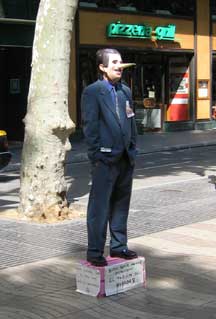 |
|
A man playing a statue on the streets of Barcelona. |
||
On a personal level, though my wife and I were quite clearly Americans – What other man in Europe but an American would wear a Hawaiian shirt and speak poor Spanish with an American accent? – we didn’t experience rudeness from any person in Barcelona, not to mention anything worse. The people we interacted with treated us kindly and respectfully.
So, though I’m the first to admit that my experience in Barcelona was not a scientifically-accurate survey of public opinion there, what I saw and what I experienced contradicted my expectations. One man who has enough time on his hands to stand like a statue with an anti-Bush poster provides the only anti-American sentiment I saw in Spain. The flourishing of Starbucks, not to mention McDonalds and Burger King, suggests that Barcelonans, even if they’re not all keen on Bush and his Iraqi policy, nevertheless are not taking it out on Americans in general.
In my next post I’ll turn my attention to France.
Does Europe Hate America? Walking Around in France
Part 2 in the series “European Reflections”
Posted at 10:00 p.m. on Saturday, June 5, 2004
After spending a day in Spain, my wife and I traveled to France, where we stayed for two days. Our first stop was Sète, a small coastal town in Southern France. Then we journeyed up the coast to Marseille. Along the way we visited two quaint French cities, Montpellier and Aix en Provence. Both of these latter cites feature large university populations, so I was particularly attuned to evidence of anti-American sentiments, which, I reasoned, might be more pervasive among young idealists.
 |
In Aix I did find one and only one piece of anti-Bush graffiti. It was inscribed on a map in the Tourist Office. It read, simply: “BUSH = MURDERER.” I looked in vain for similar markings, but all I found was this one small note. Not surprisingly, Aix also had plenty of American businesses, like a Ben and Jerry’s Ice Cream shop on Cours Mirabeau, the picturesque, tree-lined central street of Aix. Ironically, given the liberal politics of Messrs. Ben and Jerry, this shop was part of the Uncle Sam store. I saw no evidence of anti-American sentiment in or around this establishment, though there was plenty of graffiti in Aix, even on old, quaint buildings. |
While in France I did find negativity about the United States in general and President Bush in particular in two media sources. One was a small French newspaper I found in Aix, the name of which I’ve forgotten. This paper included an editorial that lectured the Americans on their need to get out of Iraq and turn the nation over to indigenous leadership. What seemed curious to me was the tone of the editorial, which assumed that America had no desire to leave Iraq unless commanded to do so by the French. The writer seemed to think that our true intention in Iraq was virtual colonization. |
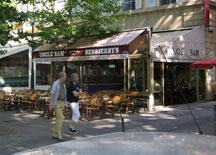 |
The other media source with a clear anti-American bias was CNN International. Yes, I’m speaking of the American-owned media company, which has a strong presence in Europe with it’s English language broadcast. Listening to the newscasters, it was almost comic to hear their negativity about President Bush and the American effort in Iraq. I say “almost comic,” because really I felt quite offended and concerned by the one-sidedness of the CNN presentation. I wouldn’t expect pro-American propaganda either, just a balanced treatment. But balance was not to be found on CNN International. Ironically, and sadly, the most anti-American experience I had in France was watching an American television station. I began to wonder if the “Europeans despise us” line so common in secular American media today is more about their bias and less about widespread European attitudes.
Let me say once more that a two-day visit to France doesn’t represent a systematic, balanced study of French opinion about the United States. I was simply a tourist keeping my eyes and ears open. But from my limited point of view I saw very little that was patently anti-American, and I experienced the French people to be friendly even though my spoken French is pathetic.
In my next post we’ll move on to Italy.
Does Europe Hate America? Walking Around in Italy
Part 3 in the series “European Reflections”
Posted at 9:00 p.m. on Sunday, June 6, 2004
Our trip to Italy took us to Florence, to the quaint costal village of Portofino, and finally to Rome, where we spent two full days. I continued to be on the lookout for anti-American sentiments, especially given the pending visit of President Bush to Italy. In Florence I witnessed a large protest in the center of the city. This parade of discontent stopped both foot and automobile traffic, pausing in the piazzas for speeches. Though I couldn’t tell the precise cause of the protest because my Italian is very limited, it seemed to do mostly with unfair conditions for the poor within Florence. A few of the protestors held up anti-war posters, but their efforts were incidental. |
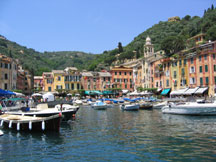 |
|
The village of Portofino on the northwestern coast of Italy |
||
Rome is filled with graffiti, some of it readable, some of it beautiful, but most of it illegible to outsiders – rather like gang-related graffiti in the United States. In my rambles around Rome I saw literally tens of thousands of pieces of graffiti. Nothing that I read was clearly anti-American. Some bits were anti-Semitic; others were anti-Arab. Most were politically irrelevant.
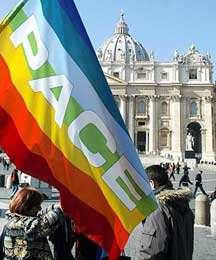 |
I was impressed, however, at the prevalence throughout Rome of rainbow-colored banners proclaiming simply: “PACE” (Italian for “peace”). These banners were draped from balconies and windows all over the city. They were especially prevalent near the Vatican. I guess that I saw at least 500 of them. Yet not once did I see any obvious anti-American or anti-Bush banner or poster attached to the pervasive proclamations of “pace.” This would suggest that many Italians are eager for peace, presumably in Iraq, but not especially anti-American. They may not support the current administration’s approach to making peace in Iraq, but they aren’t translating opposition to policy into generic anti-Americanism. |
|
A PACE banner in the piazza in front of St. Peter's Basilica |
||
Yesterday my wife listened to NPR, which included interviews of Italians on the occasion of President Bush's visit to Italy. The Italians were asked about their feelings for America in light of the war in Iraq. The persons interviewed opposed American (and Italian) involvement in Iraq, yet they didn’t therefore despise America in general. Moreover, they remember with gratitude the American effort to free their country from the domination of Hitler during World War II.
I wonder if someday the people of Iraq will think of America in this way. Will they remember our effort there as a successful struggle to liberate them from tyranny? This will only happen, of course, if our effort in Iraq is successful. For this I pray, and for those upon whose shoulders lies the responsibility for ensuring this result.There Are Lots of Foreigners Here!
Part 4 in the series “European Reflections”
Posted at 9:00 p.m. on Monday, June 7, 2004
One of the things I most enjoy about traveling is walking around in a new city, simply drinking in the sights, smells, and sounds. So, soon after my wife and I arrived in Barcelona, Spain, we headed out to the streets.
One of the main thoroughfares in Barcelona is called “La Rambla” (or sometimes plural, “Las Ramblas,” because the street consists of several smaller streets and squares. “La Rambla” means, simply, “The Boulevard.”) This street has a unique design, with a broad, center sidewalk filled with pedestrians, vendors, and entertainers. Underneath a thick canopy of Sycamore tree leaves, Barcelonans buy flowers and fruit, while enjoying the company of the crowds. As my wife and I ambled along, I was suddenly struck by the fact that people weren’t speaking English, but Spanish or Catalan (a Romance language popular in Barcelona). Of course this wasn’t a terribly profound observation, but it’s one of those things that tourists experience when they first arrive in a foreign country. Turning to my wife, I said, “Wow! There sure are lot’s of foreigners here!” |
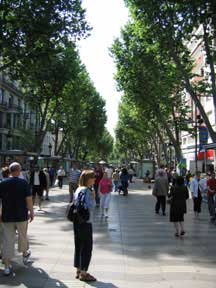 |
|
La Rambla in Barcelona, Spain |
||
In Barcelona I was reminded of what it’s like to be a cultural outsider, even though I can muddle through in Spanish and I was still in Western Europe. Take the pace of life and daily schedule, for example. People in Barcelona don’t get up at the crack of dawn to hurry to work. The Starbucks stores in this city open at 8:00 a.m. – not 5:30 a.m. as in the good ol’ workaholic USA. In the early afternoon many of the shops and restaurants actually shut down for two hours as people observe the Spanish tradition of a siesta. Then, at night, most restaurants don’t open until 9:00 p.m., and don’t fill up until 10:00 or 11:00. (As a night person by nature and a lover of naps, I should think about relocating to Barcelona!)
Although everyone we interacted with in Barcelona treated my wife and me cordially, we were, nevertheless, strangers in a strange land. Though we felt safe, we didn’t feel at home . . . because we weren’t.
The New Testament suggests that this is how we who are Christian ought to feel about life in this world. According to the Apostle Paul, “our citizenship is in heaven” (Phil 3:20). Thus, though we live in this world, we can feel like strangers in a strange land, like people who just don’t fit in.
Have you had this experience? Perhaps when a colleague at work just assumed that you’d exaggerate your business expenses to squeeze a few more bucks out of the IRS. Or perhaps when your friends all agreed that right and wrong are a matter of personal opinion, while you insisted in moral absolutes. Or . . . you fill in the blank.
How are we to live as resident aliens in this world? Paul gives this answer: “Live your life as citizens worthy of the gospel of Christ” (Phil 1:27, my literal translation). In others words, we are to live in such a way that people see in our differentness a reflection of the good news of what God has done in Christ. In a world that is often harsh, judgmental, and unforgiving, we are to show mercy, grace, and forgiveness. By loving others we will reveal our true citizenship as those who belong to the God of love.
As we look around us at our neighbors, we might well say, “There are lots of foreigners here!” Our calling is to help them find their true home in God’s kingdom.
There’s a Lot of Old Stuff Here!
Part 5 in the series “European Reflections”
Posted at 9:00 p.m. on Tuesday, June 8, 2004
I live in a city that’s 30 years old. A few buildings in town actually date back to the early part of the 20th century and these are regarded as something special. Protected historical buildings, and that sort of thing. Of course in California we have our Spanish missions, some of which are over 200 years old. Where I live, that’s really old.
In Europe, that’s relatively new. The continent if filled with structures that are many centuries old. Some date back over a thousand years. Then there are the ruins in places like Rome, many of which are the remains of buildings that were built over two millennia ago. Plop down a California mission in Rome and it wouldn’t even get a historical landmark sign! People react differently when exposed to old stuff. Some are bored silly. Others are tantalized, drawn by the magnetism of historical curiosity to investigate ancient monuments. My own reaction when exposed to antique buildings is rather different. |
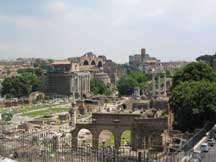 |
|
| The ruins of the Forum in Rome, where most buildings are around 2000 years old. | ||
At first I feel humbled as I realize that the world is much bigger and older than I sometimes think. It’s easy for me, a product of the boomer mindset, to live as if our generation is the first one on earth that really matters. We value innovation and look toward the future, often forgetting or denigrating the past. But when the past looms wherever I look, I’m forced to remember that my generation and I are neither the first or the best people to have lived on this earth. We’re just one more bunch of people who will spend perhaps 80 years in this world, and then we’ll be gone. As the song goes, we’re “dust in the wind.”
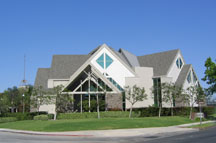 |
And so will be many of our achievements. In the last decade, the church I pastor labored hard to build a wonderful new sanctuary. It is a marvelous place for worship and I’m thankful for the privilege of having been a part of the building process. But someday our building will be old. Or perhaps there will be a massive earthquake in Orange County and our sanctuary won’t even survive. These thoughts don’t make me less glad to have built a sanctuary, but they do put that project in perspective. They remind me that I want to live for what really matters. I want to live, not only in light of history, but in light of eternity. |
|
The sanctuary of Irvine Presbyterian Church |
||
In one of his letters the Apostle Paul reveals that the time will come when the works of our life will be judged as if in a scorching fire. Only that which has eternal value will remain (1 Cor 3:10-15). And what has eternal value? Not buildings. Nor programs. Nor fame. Nor fortune. What has eternal value? People. Relationships. Knowing God. Love. Truth. “The grass withers, and the flowers falls, but the word of the Lord endures forever” (1 Pet 1:24-25). These are the things in which I want to invest my short time upon this earth.
Don’t Get a Big Head!
Part 6 in the series “European Reflections”
Posted at 9:00 p.m. on Wednesday, June 9, 2004
When I was a boy, my mother was always warning me: “Now don’t get a big head!” She perceived, rightly, I’ll admit, that I had a tendency to feel more than a healthy degree of pride. If I accomplished something special, and especially if I beat others in the process, my head did indeed have a tendency to swell up. My mother’s counsel was right on target. My mother never visited Rome while I was young. If she had, she might have added to her warning: “Now don’t get a big head like Augustus!” Prominently displayed in a courtyard of the Vatican Museum is a giant head, a carved representation of Augustus Caesar. According to historians, this head once topped a statue of the entire body of the Roman Emperor – a statue that would have been fifty feet tall. It was erected, in all likelihood, at the behest of Augustus, and prominently displayed in the center of Rome. |
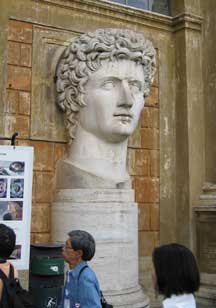 |
|
The giant head of Augustus |
||
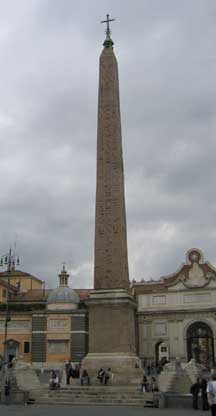 |
I doubt Augustus’ mother told him not to get a big head. Rome tended to be much less hesitant about pride than we are. In fact Augustus, like all prominent Romans, was encouraged by his culture to trumpet his achievements, which he did with a particular passion. In fact Augustus referred to himself in public inscriptions as “DIVI F,” a Latin abbreviation for “Son of the Divine Caesar.” Though not directly claiming to be a god, by referring to himself as the son of a god, Augustus wasn’t leaving much room for guessing about his divine status. (Indeed, he was deified soon after his death in A.D. 14.) Historians acclaim Augustus as one of the great administrators of history. Under his able rule, the Roman Empire experienced unprecedented peace (the pax romana) and prosperity. Yet, ironically, all that remains of his giant statue is a big head. And this head is not the focal point of some temple in honor of Augustus the god, but is simply one exhibit in the immense Vatican Museum – a museum that ultimately honors someone who was merely an insignificant Jewish boy during the years of Augustus’ reign. |
|
An obelisk in the Piazza del Poppoli in Rome. Erected by Augustus in his own honor. Includes the DIVI F inscription. |
||
What do I take away from these reflections on Augustus? I reminded to heed my mother’s sage advice: “Don’t get a big head!” No matter how pleased I might be with myself, no matter how proud of my accomplishments, I must never let pride dominate my heart. This is true, not only because I’m my mother’s son, but ever moreso because I’m a Christian.
Whereas first-century Romans held up pride and boasting as appropriate virtues, the early Christians valued humility. In fact they used a Greek word, tapeinophrosune, to signify godly humility, even though this word had a negative connotation in secular Greek usage. For example, Paul writes to the Philippians: “Do nothing from selfish ambition or conceit, but in humility [tapeinophrosune] regard others as better than yourselves” (2:3). And why should Christians adopt such a counter-cultural posture of humility? Because Christ “humbled himself and became obedient to the point of death” (2:8). The one who humbled himself on the Roman cross is now worshipped throughout the world as God. The one who held himself up as the great emperor and son of a god is now a historical curiousity. What keeps me from getting a big head? More than anything else, the cross of Jesus Christ. The cross reminds me of my utter dependence upon God and his grace. The cross reminds me that Jesus, being in very nature God, nevertheless humbled himself. The cross calls me to live, not for my glory, but for the glory of the One who gave his life for me. |
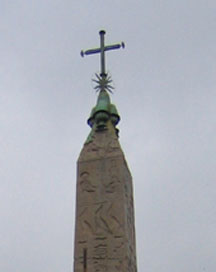 |
|
Ironically, the top of Augustus' obelisk is now crowned with a Christian cross. |
||
Who Won? Rome or Christ?
Part 7 in the series “European Reflections”
Posted at 9:00 p.m. on Thursday, June 10, 2004
The relationship between Christianity and the Roman Empire was an odd and varied one. During the first three centuries A.D., Christians were often persecuted and sometimes even killed by Roman authorities. Usually persecution of Christians was regional and sporadic, but at times it was widespread throughout the empire. The worst seasons of terror occurred under the reigns of Decius (c. 250) and Diocletian (c. 300).
| But then, not long after Diocletian abdicated the throne in A.D. 305, a miracle occurred. As the story goes, in A.D. 312 the Roman Emperor Constantine had a vision in which he saw a Christian symbol with the legend, “In this sign, conquer.” Fighting in the name of the Christian God, Constantine was victorious in a crucial battle at Milvian Bridge. Shortly thereafter he issued the Edict of Milan, which allowed Christians to practice their faith openly. In the years that followed, Constantine seemed to be a Christian himself, and shortly before his death in A.D. 337 he was baptized as a believer. | 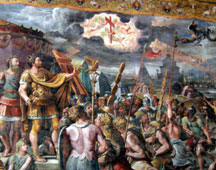 |
|
Raphael's fresco of Constantine's vision. |
||
Without a doubt, Constantine’s conversion and subsequent activity as emperor secured freedom for the Christian church. In time, of course, the Roman Empire fell, while the church prospered in size, wealth, and power. Thus it is common to speak of the ultimate victory of Christianity over Rome, and to see this victory as beginning with Constantine.
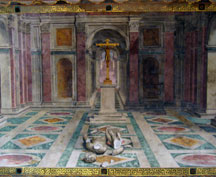 |
In one of the rooms in the Vatican Museum (the so-called “apartment,” because it was once a papal residence), the great Italian painter Raphael depicted in stirring imagery the victory of Christ in the time of Constantine. The walls of the room are covered with elaborate frescoes portraying Constantine’s conversion and military success. But on the ceiling is perhaps the most powerful image of Christ’s victory. There, before a statue of the crucifixion, is a crumbled statue of a Roman deity. Through the Emperor Constantine, the crucified Christ has defeated paganism, the paganism that was at the heart of the Roman Empire. | |
Christ on the cross defeats the pagan god. |
||
Along with many Christians throughout the ages, I wonder who actually won the battle between Christ and Rome. Yes, on the one hand, Christ was obviously victorious. Yet when I examine what happened to the church of Jesus Christ in and after the time of Constantine, I can’t help but feeling that in some ways the church lost at least a part of the battle. What began as a vibrant, evangelical, and spiritually-motivated movement became a staunch, ecclesiastical, and world-obsessed institution. It seems that, in many ways, the church didn’t defeat Rome. Rather, it absorbed Rome and many Roman values.
My point here is not to criticize the Roman Catholic church, however. Instead, I want to look at myself and my church in light of what happened to the Roman church. I wonder: To what extent have we bought into the worldly values of our culture? To what extent are we dominated by these values, without even knowing it? Are we willing to stand for the truth of Christ, even when this truth is unpopular? Or are we apt to compromise the truth in order to gain secular influence and affirmation?
Increasingly these days, politicians on both the left and the right are courting the church. Actually, the left has been doing it for decades. The right is a recent player in the “court the church” game. I can understand the motivation of politicians in this matter, because the church includes a whole bunch of potential voters. But I hope the church is careful to remain faithful to our one Lord and his truth. Though we are called to be active as citizens in the world, our first citizenship is in heaven. As citizens of heaven we are called and empowered to examine the agendas of all political parties in light of God’s truth, to speak critically and prophetically to all sides as needed. If ever the church becomes so closely allied with any one political movement that it loses the ability to critique that movement in light of God’s truth, the church runs the risk of losing its soul in the process.The Excellence and Excesses of Art in Worship
Part 8 in the series “European Reflections”
Part 5 in the series “Visual Arts in Faith and Worship” ![]()
Posted at 9:00 p.m. on Monday, June 13, 2004
Europe is filled with churches. And these churches, though no longer filled with people, are filled with art: great art, beautiful art, priceless art. Of course I’m referring to Catholic churches, because most Protestant churches, in reaction to what was believed to be Catholic excess, severely limited or even banned artistic expression from places of worship. Some of the most excellent art in the world can be found in European churches. And I’m not referring only to the most famous examples, such as Michaelangelo’s Pietà in St. Peter’s Basicila in Rome, or the astounding frescoes of the Sistine Chapel. Consider the cathedral in Barcelona, for example. It is filled with paintings, statues, and other art objects. Its stained glass windows are particularly stunning. As a lover of beauty and religious symbolism, I couldn’t help but be moved by the excellence of the art in this cathedral. |
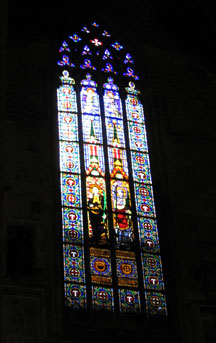 |
|
From the Barcelona Cathedral |
||
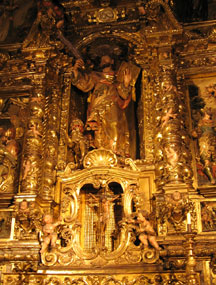 |
But I also had to wonder: Does artistic excellence ever become excessive? Consider, for example, one of the most striking artistic displays in the Barcelona Cathedral, a small chapel in honor of St. Mark the evangelist. My small photo can hardly do justice to the golden glow, indeed, the rich opulence of this chapel. Its intent is to honor St. Mark, the writer of the second gospel, and to inspire prayer. But is there too much gold here, too much elaboration, too much worldly excellence? Should some of the money invested in this chapel have been used to feed the poor or clothe the naked? I stand too far away from this chapel’s artist and his world to understand his values and priorities. Maybe he created this chapel with every intention of glorifying God. And maybe God was indeed glorified by his creation. But I still have to wonder if so much gold, so much lavishness, goes beyond some standard of Christian artistic excellence. When you consider that the Gospel of Mark is a call to servanthood and suffering, it’s hard to see how Barcelona’s golden chapel is congruent with the heart of the biblical writer it celebrates with such opulence. |
|
The Chapel of St. Mark in the Barcelona Cathedral |
||
Yet I don’t want to enter through the wide gate of dumping on the excesses of somebody’s else’s Christian art and thereby avoid the narrow gate of self-examination. Although the sanctuary of my church is not nearly as lavish as the Barcelona Cathedral, it does include several works of visual art, notably in our glass windows. What makes my windows okay and the Chapel of St. Mark excessive? How can I judge if and when my commitment to artistic excellence becomes excessive? If the hearts of the artists (and, indeed, the benefactors) are truly set upon glorifying God, are any artistic expressions okay? Is there ever a point when one can say, “This piece of art is too much, too elaborate, or even too expensive”? Or could it be that, as long as human motivations are right, no work of art could be too glorious, since it is meant to glorify the God whose glory is boundless? |
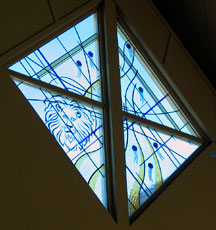 |
|
A window in the Irvine Presbyterian sanctuary, signifying the lion in Rev 4:7 |
||
For those of you who like answers, this blog entry will be frustrating. I’m not yet ready to answer the questions I’ve asked. I’m still mulling them over. If you have any ideas, please e-mail me.
Images of Jesus in Christian Tradition
Part 9 in the series “European Reflections”
Part 6 in the series “Visual Arts in Faith and Worship”
Posted at 9:00 p.m. on Tuesday, June 15, 2004
In some of my discussions of Mel Gibson’s movie The Passion of the Christ, I mentioned how much the filmmaker’s visual representations of the crucifixion reflected Roman Catholic art throughout the centuries. (See, for example, “Satan and the Demonic Baby . . . Huh?”)
Now, having recently visited many churches in Southern Europe, I’m even more impressed with how fluent Gibson is in the “language” of Catholic Christian art. Of course every church I visited had at least one crucifix, if not several. But I was impressed with other visual representations that Gibson captured in his movie. For example, all of the churches included the traditional “Stations of the Cross,” visual images of Jesus’ suffering, images that include many dramatic falls as he carries the cross to Golgotha. (This was something non-Catholics often didn’t “get” in The Passion of the Christ. A common question was: “Why did Jesus have to fall so much while carrying his cross?” Answer: “Because it’s consistent with the stations of the cross.”) One of these stations is an encounter between Jesus and his mother on the Via Dolorosa, one of the most powerful moments in Gibson’s film, yet something that is not narrated in the biblical gospels. |
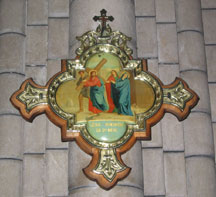 |
|
One of the stations of the cross in the cathedral in Monaco, where Jesus meets Mary on the Via Dolorosa |
||
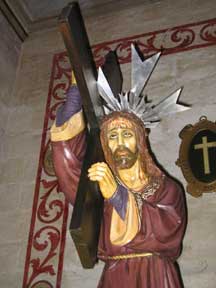 |
But I was especially struck by the large number of representations of a suffering Jesus. One of the most stirring was in a church in Mahon, on the island of Menorca. I don’t know anything about the date of this sculpture. But I do know that I found the grief of Jesus to be deeply moving. In my Protestant upbringing, I can’t remember ever seeing a picture of a “sad” Jesus. We focused instead on the loving Jesus (Jesus and the children) or the “strong” Jesus (both pre- and post-Resurrection). Of course it’s not wrong to display images of the caring, powerful Jesus. And it’s not wrong to portray him in his agony. The problem comes when things get out of balance, when we emphasize only certain dimensions of Jesus’ life to the exclusion of others. It seems to me that most Christian traditions fall into this trap. |
|
An image of Christ from the St. Francis Church in Mahon |
||
Some Christians solve this problem by prohibiting all visual images of Jesus. I believe, however, that there is a biblically defensible place for graphic depictions of Christ. But I also believe we need to strive for balance and completeness as we display these images. Perhaps one of the advantages of the greater interaction between Protestants and Catholics will be a broadening of our understand and experience of Jesus, along with a parallel expansion of our visual traditions. Wouldn’t it be something to find a crucifix in a Protestant church, and an empty cross in a Catholic cathedral?
Re-Creating the Bible in Our Own Image
Part 10 in the series “European Reflections”
Part 7 in the series “Visual Arts in Faith and Worship”
Posted at 9:00 p.m. on Wednesday, June 16, 2004
When we create visual images of Bible stories, it’s natural for us to create them in our own image. We tend to make Bible characters look like us and even act like us.
| I was struck by this fact as I visited many churches in southern Europe. In the Cathedral of the Immaculate Conception in Monaco, for example, I was impressed by a sculpture of Mary and Jesus, the Madonna and child. This is a strikingly beautiful sculpture, with a “perfect” woman holding a “perfect” baby. They look perfect if you happen to be from Western Europe, I should add. My guess is that neither of these figures would measure up to the Semitic image of perfection. And, of course, the real Mary and the real baby Jesus not only didn’t look European, but also it's unlikely that they were crowned with lavish, golden, jewel-filled crowns in the Bethlehem stable. The sculpture of the Madonna and child from the church in Monaco is clearly an idealization, not an attempt to portray the historical Mary and Jesus. | 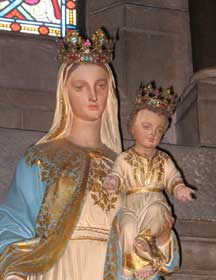 |
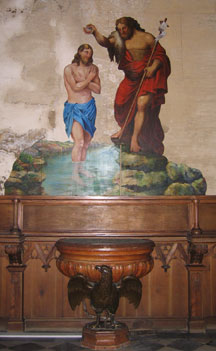 |
In Mahon, a city on the small island of Minorca, I was impressed by a fresco of the baptism of Jesus that adorned the baptismal niche of the Church of Santa Maria. John the Baptist is baptizing Jesus in the Jordan River, but not by immersing him in the water. Rather, John is pouring water on Jesus’ head from a small shell he holds in his hand. This picture reflects the tradition of the Minorcan church more than what really happened in the baptism of Jesus. Quite certainly Jesus was baptized through immersion. As the Gospel of Mark reads, “In those days Jesus came from Nazareth of Galilee and was baptized by John in the Jordan. And just as he was coming up out of the water, he saw the heavens torn apart and the Spirit descending like a dove on him” (Mark 1:9-10). If Jesus was “coming up out of the water,” then he had previously been down in it. (You can trust me on this, because I’m a Presbyterian, not a Baptist. Most of the time I baptize by sprinkling, not immersion. No theological agenda here!) |
You’ll notice that my descriptions of what I saw in Monaco and Mahon are objective. I haven’t weighed in on whether I think it’s good or bad that our artistic representations of biblical stories tend to paint reality in ways that fit our own culture, rather than the biblical culture. In fact I think this can be good or bad or both. On the one hand, visualizing biblical stories in ways that are familiar to us helps us to “get into” the story. It’s a way of translating the biblical text into a more familiar idiom (much as we do when we translate New Testament Greek into English). On the other hand, such graphic translation can fool us into thinking that our way is “the biblical way,” without realizing how far we may be from biblical reality.
When it comes to visualizations of Jesus, if we see Jesus simply as one just like us, we’ll tend to miss his distinctiveness as a Jewish man. Thus it will be easy for us to misconstrue his message and ministry as well, both of which can be understood only in their Jewish context. (See my book, Jesus Revealed, for ample evidence of this.) Even more dangerous is the tendency, once we have envisioned Jesus as a Western European, to become anti-Semitic. If we’re continually confronted by images of very Jewish Jesus, however, it will be harder to look down upon Jews in general.
I do not think artists who portray biblical images must strive for historical literalism. They are free to be creative in the reinterpretation of the biblical stories. Yet it’s crucial for those of us who are influenced by their art to see reinterpretations for what they are, and to discern an artist’s distinctive statement without projecting that statement onto the biblical text.
Michaelangelo’s Surprising Sistene Reticence
Part 11 in the series “European Reflections”
Part 8 in the series “Visual Arts in Faith and Worship”
Posted at 9:00 p.m. on Thursday, June 17, 2004
One of the highlights of my recent trip to Europe was a visit to the Sistine Chapel. (Note to future travelers to Rome: You can’t visit the Sistine Chapel all by itself. It’s the final part of the trek through the giant Vatican Museum. You don’t have to go through the entire museum to see the chapel, but you can’t go straight to the chapel either. Of course I would highly recommend that you take at least a couple of hours to make your way through the astounding exhibits in the whole Vatican Museum.) The Sistine Chapel is perhaps the most famous church in the world (vying, I suppose, with St. Peter’s Basilica). At any rate, the art in the chapel is the most well-known of all church art. It includes stunning presentations the biblical story, including the Creation on the ceiling and the Last Judgment on the wall above the altar. |
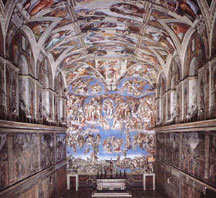 |
|
The front wall and ceiling of the Sistine Chapel. The Creation is at the very top of this picture. The Last Judgment is straight ahead, above the altar. |
||
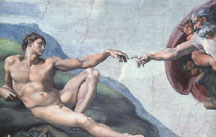 |
The most well-known portions of the chapel were painted by Michaelangelo, who had been personally chosen by the Pope of his day for this task. I knew this before my visit to the chapel. What I did not know until this visit, however, was that Michaelangleo really didn’t want to take on this project. Why not? Because he thought of himself primarily as a sculptor, and not a painter. He wasn’t sure he could do justice to the material in only two dimensions, and so he tried to get out of the job. But the Pope remained steadfast, and so Michaelangelo ended up creating one of the world’s greatest masterpieces. | |
The creation of Adam, from the roof of the Sistine Chapel. (Note: I did not take any of these pictures. Visitors to the chapel are not allowed to take pictures.) |
||
If find this story both surprising and, somehow, comforting. It reminds me of my relationship with God. God often, it seems, wants me to do things I don’t necessarily want to do. For example, I did not at first have any interest in becoming the pastor of Irvine Presbyterian Church, and came very close to rejecting the interest of the church’s search committee. Being the senior pastor of a medium-size suburban church just didn’t fit my picture of what I was best suited to do. But God had other plans, a fact for which I am now very glad. Like Michaelangelo, my job was to be obedient to my authority and to trust the results to God. My work at Irvine Presbyterian will never be thought of as a masterpiece, but God has used and blessed my efforts for his glory.
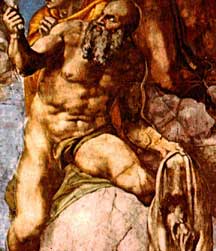 |
One final note of interest: On the massive Last Judgment wall there is a picture of St. Bartholomew. This saint, one of the 12 original disciples of Jesus, is believed to have evangelized in the East, including Iran and Armenia. He is said to have been martyred by being skinned alive. Michaelangelo represents this tradition by picturing the resurrected Bartholomew holding a human skin. But the face on this skin looks nothing like the saint. Most art historians believe that the face on the skin is actually that of Michaelangelo himself, who, like many painters of his era, including himself in his painting. But what an ironic and humble form!
|
|
Michaelangelo's picture of St. Barthelomew holding a skin with a surprising face. |
||
No Shorts Allowed!
Part 12 in the series “European Reflections”
Posted at 9:00 p.m. on Saturday, June 19, 2004
As my wife and I visited many churches throughout southern Europe, I noticed a consistent dress code. Visitors to the churches were not allowed to wear shorts (above the knees) or tank tops. Even more casual apparel (like bathing suits) was completely forbidden. Many churches had other prohibitions as well, like no flash photography, no eating, or no pets. Even though most of the visitors in these churches had come, not to worship, but simply to gaze at beautiful art, they were expected, nevertheless to act with a measure of reverence and respect for tradition. My mind was filled with many thoughts as I considered the ecclesiastical dress code. On the one hand, I thought back to first-century Corinth, where some women had taken off their veils during Christian gatherings (in homes, not sanctuaries). Ironically, this was rather like if women were to wear mini skirts into a church meeting today. Veils, in first-century Corinth, were worn as a demonstration of modesty. An unveiled head in that day was sexually provocative. So, though styles have changed over the ages, the fundamental value of modesty is still preserved in many European churches. |
|
|
This sign was posted on the front door of a church in Monaco. Does the bottom right image mean "no food" or "no ice cream" or "no ice cream that's dripping"? |
||
This struck me as ironic, especially in churches featuring nude paintings or statues. One cannot wear shorts into the Sistine Chapel to view anatomically accurate paintings of dozens of nude men and women. Of course these nudes weren’t meant to be erotic. They reflected the Renaissance delight in humanity and the beauty of the created world.
I thought of how all of this would translate into my world, the world of Southern Californian Christianity. Now the irony multiplies. Although many churches in my part of the world would welcome people in shorts, tank tops, and other casual attire, they’d never allow a nude painting or statue. Moreover, many of those Southern Californians who come to worship so casually dressed nevertheless come with a fervent desire to offer genuine worship to the living God. Their bodies may look irreverently casual, but their hearts are often filled with genuine reverence.
Surely what’s in our hearts matters most. I’d rather worship in an spiritually-alive but overly casual Southern Californian megachurch than in an spiritually-dead European cathedral. Yet I wonder if we’ve lost something by allowing ourselves to approach God so casually. By saying (and singing) again and again, “Come, just as you are to worship,” we run the risk of minimizing the awesome holiness of the One into whose presence we come when we worship. True, we are allowed into God’s presence, not because we are dressed up, but because we are dressed in the righteousness of Christ. Yet I fear we can too easily take all of this for granted. I know I can.
 |
I’m not planning to put up a sign on my sanctuary like those I saw throughout Southern Europe. Indeed, I want to welcome all who would come into worship at Irvine Presbyterian Church, even if they may be underdressed. Ironically, I saw more bare midriffs in church on Easter than on any other Sunday, presumably because some of our guests didn't think twice about coming to church in such casual and even provocative attire. But I've got to tell you, I'm glad they were there. Nevertheless I hope that my church members, no matter how they dress, will come to worship with a sense of eagerness and reverence. If dressing up a bit helps them to be mentally and emotionally prepared for worship, then by all means they should dress up. And, please, no dripping ice cream in the sanctuary! |
|
A picture of the inside of the sanctuary at Irvine Presbyterian Church, sans ice cream drips. |
||
